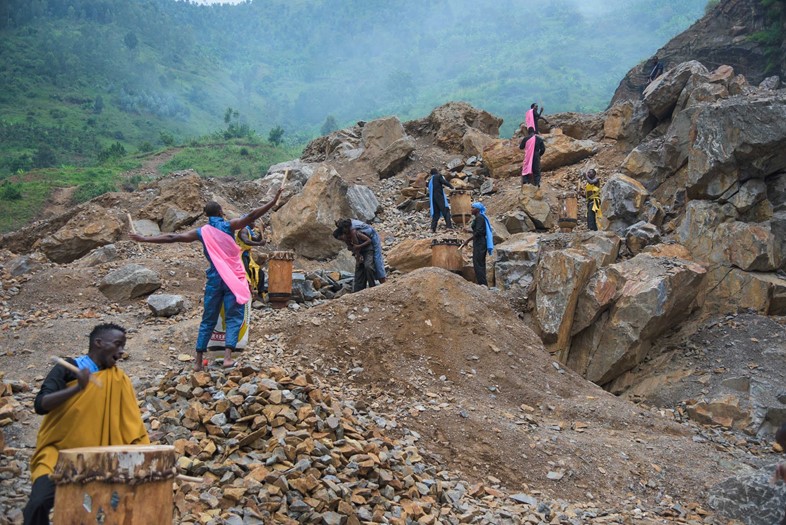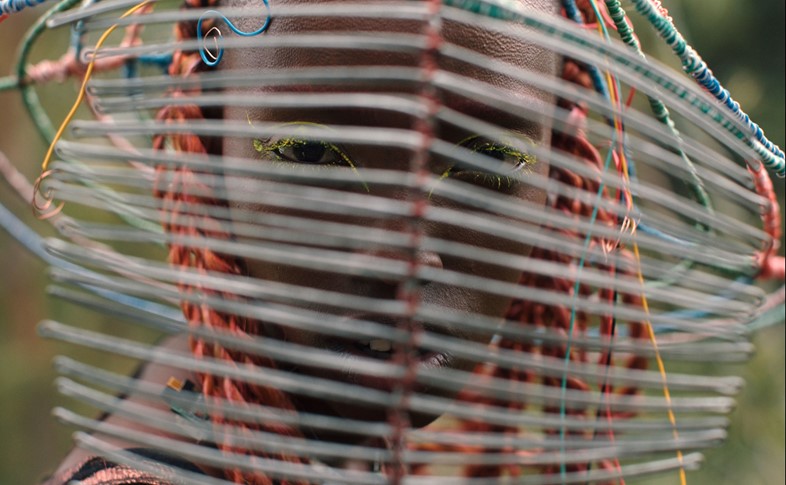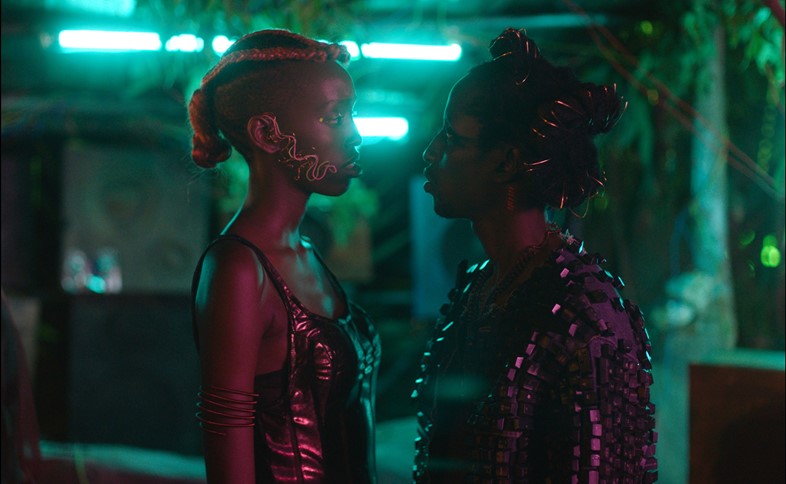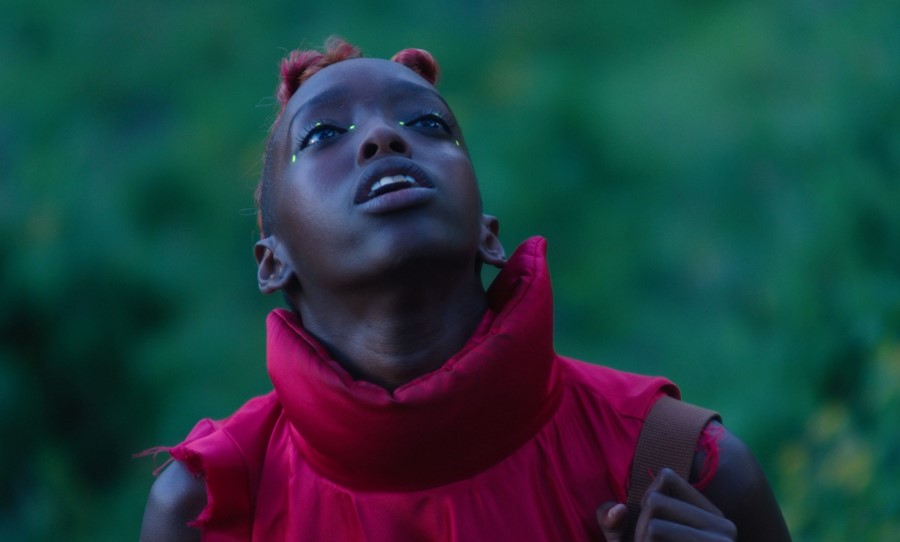As Neptune Frost hits cinemas, Anisia Uzeyman and Saul Williams talk about their visionary new film – an anti-extractivist, genderqueer, sci-fi musical taking aim at capitalism and colonialism
Neptune Frost is an odyssey of ancient and futuristic imagination. An anti-extractivist, genderqueer, sci-fi musical, Anisia Uzeyman and Saul Williams’s film tells the story of a fateful collision between two searching souls, intersex hacker Neptune (played first by Elvis Ngabo, then Cheryl Isheja) and coltan mine worker Matalusa (Kaya Free). Both are fleeing the systemic violence of ‘The Authority’, and step through an interdimensional portal to Digitaria – a haven for those who dare to imagine political and technological possibilities beyond capitalism, beyond colonialism, beyond binaries.
In Digitaria’s fluorescent and radical vision of the future, the aesthetic is political, and vice versa. The poetry, music and cyberpunk fashion of resistance storms on to the screen and flips off the camera: its visual and sartorial topography is constructed from upcycled computer parts, while the dynamite score (written by Williams, a rapper and songwriter) brings together hip-hop, electronic music and the polyrhythmic drumming of east African folk tradition. Thrumming with the energy of so many struggles for liberation – and with a fierce, uncompromising focus on how all are intertwined – Neptune Frost possesses the world-building energy of a supermassive star.
AnOther spoke with Williams and Uzeyman about Neptune Frost’s genesis, tracing the roots that connect us, and the art of revolution.
Xuanlin Tham: Saul, as writer and composer, and Anisia, as director of photography, your creative partnership seems to mirror Matalusa and Neptune in how an exchange between two individuals powers a whole world. What was that collaboration like?
Anisia Uzeyman: The first thing I’m thinking when you say ‘two’ is that there’s more than two! It’s true that in the film there is a very strong theme of connecting, and being empowered when you step into your own consciousness. And it’s a love story, too.
Saul Williams: It [was] crucial to have a film that imparts some sense of what we’ve travelled, learned, explored. In terms of collaborating with Anisia, there’s no way I could envision this story being told without this union. But it’s also true that this union involves so much, and so many.
AU: I was very lucky as the person thinking about the images to be next to the person composing the music – to be in the laboratory of those things together. So, the question was about [parallels with] Matalusa and Neptune, and of course [they’re there]. Of course.
SW: It wasn’t consciously –
AU: It was! It was written. [Laughter].
SW: Well, yeah, it was written for us initially. The initial dream of Neptune Frost was a stage musical, and I envisioned both of us in it. I’m so thankful we didn’t go that route. Our executive producer loved the script, but was like, ‘I think it’s a film.’ That freed us in many ways. If I was writing a musical for Broadway or the West End, it was going to be in English. Once we thought of it as a film, we could dream of location, we could dream of actors … my excitement became the subtitles. [laughs]. Oh my gosh, you know, I can have fun!

XT: Neptune Frost pays homage to the past and reclaims the tools of the present to explore what a futurescape looks and sounds like. What inspirations did you draw from?
AU: So many. We spent more than seven years researching. We went in 2016 to do a sizzle-reel in Rwanda – we met so many people, and pulled from those stories really concretely. The range of inspiration [goes] from student protests in Burundi, the Arab Spring, the hackers’ movements … It is very inspired by political movements, and the rising of a new generation of activists influenced by technology.
SW: The first thing we learned about was e-waste camps, and their proximity to the coltan mines. And connecting that to the realities of the past, which is that all the stuff we lean on – gold, diamonds, coffee, sugar – comes from the same place as these resources that our technology depends on. Musically, [I was] speaking of polyrhythm as ancient technology. It’s there when you do the folkloric search into the past, but [also] moving forward to electronic music, drum’n’bass and trap.
AU: Talking about being inspired by the place where we shot the film, the ensemble of Burundian drummers were in fact refugees. They’re an ancient entity.
SW: Very ancient. But in contemporary music history, Johnny Rotten and Adam Ant talk about the Burundian drummers, specifically the album Les Maîtres-Tambours du Burundi, as the inspiration for post-punk. So, these connections were super-inspiring to weave worlds with, to think of the connecting circuitry.
AU: To weave polyrhythm with wireless communication.
SW: I wanted to see a musical that reflected the kind of music I dream of hearing. Through that, we were able to imagine the characters, imagine Digitaria. Sound first. Ironically, the thing I was playing with was removing the drums. There’s a lot of songs without drums, where the voice provides the framework of where the rhythm falls. The drum is implied; [they] happen in your head.

XT: The prophetic wheel-man in the dreamscape is a really beautiful, striking image. How did this character arise?
SW: The third person in our creative process is [costume designer] Cedric Mizero, who costumed that character, Potolo. I’ll never forget the day we went to Cedric’s studio, and he’d made this contraption of bike wheels. He’s like, ‘So, this is for Potolo. Put it on.’ And you see it spinning. Holy fuck. Potolo in the Dogon language means ‘Sirius’, and one point of inspiration was the way ancient African cosmologies connected to the idea of virtual, non-binary space. Potolo was a way of weaving ancient tech into future tech. Both [Matalusa and Neptune] fall asleep under acacia trees, and the thing that connects them is the roots under the earth: we think of that ancient communication as the first world wide web.
AU: [to Saul] In the script, it’s so beautiful, what you wrote … but so crazy. [Both laugh.]. Trying to find a visual solution – I love when it goes beyond what you can imagine. Everybody was really creative, since we couldn’t go into the ground and follow the roots of those trees. I’m thinking of the make-up artist, the light director.
SW: One of the points of magicality … you arrive at 6pm, you don’t shoot until, like, 3am because they’re painting rocks and building a rollercoaster for the camera. And once everything’s set up: poof. The generator goes out. But because they’ve been painting everything, and it’s a full moon overhead, it lights up. We’re like, ‘Keep shooting!’ That, to me, is the craziest thing about that scene. The power goes out, but the way everything lights up under the moon as a result? That is a true illumination. [laughs].

XT: That’s incredible! A divine moment.
SW: Oh, the film is full of those.
XT: Towards the end, one character asks another: why poetry, as a method of resistance? Why not revolt? Where do you think art lies in that conversation?
AU: I love that scene. I was dreaming of seeing people have a conversation about invisible questions that are so important to the moment we are living in. And to define what power is. What does it take from us? What are we pouring it into?
SW: Everybody has to play their role. If you’re an engineer, it’s not like you need art to do the thing. You need to apply your passion, your craft, to that forward movement. As artists, the application of our craft to that forward movement manifests in films like Neptune Frost. Revolutionaries need inspiration. In what we know is a truly bloody and crazy fight to engage in, how do you applaud the courage of a generation? The fire needs applause. You have to fan the flames.
Neptune Frost is out now.
